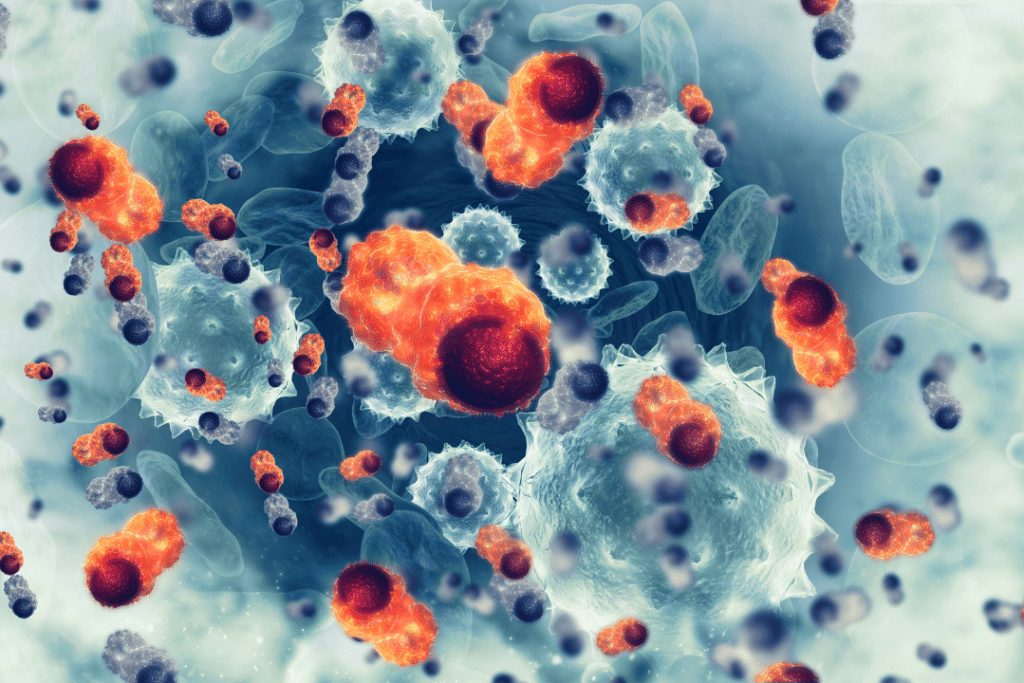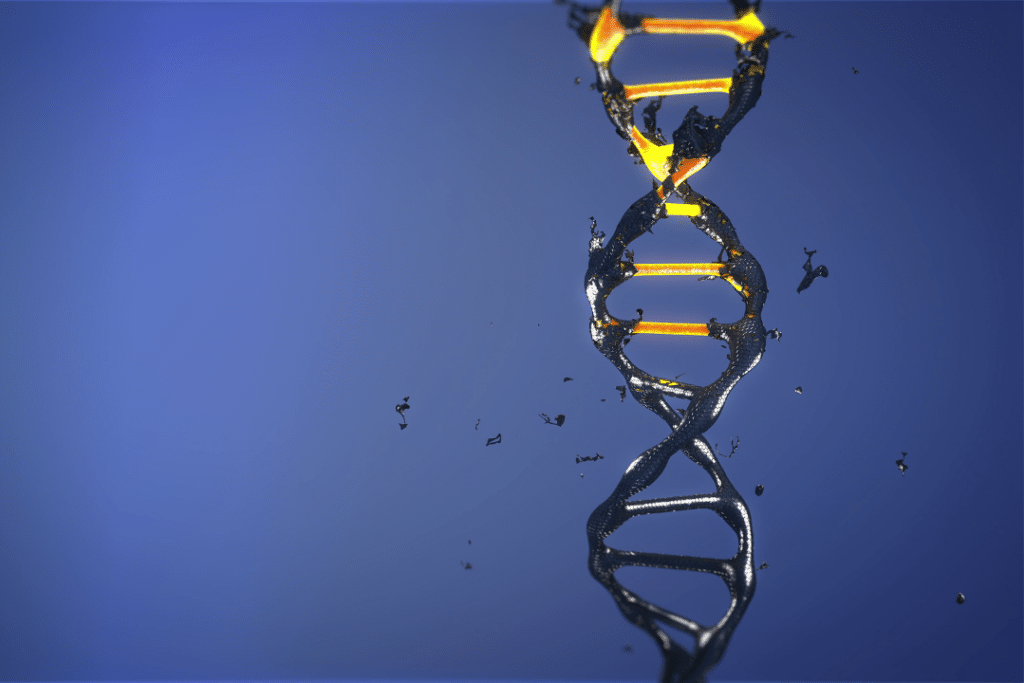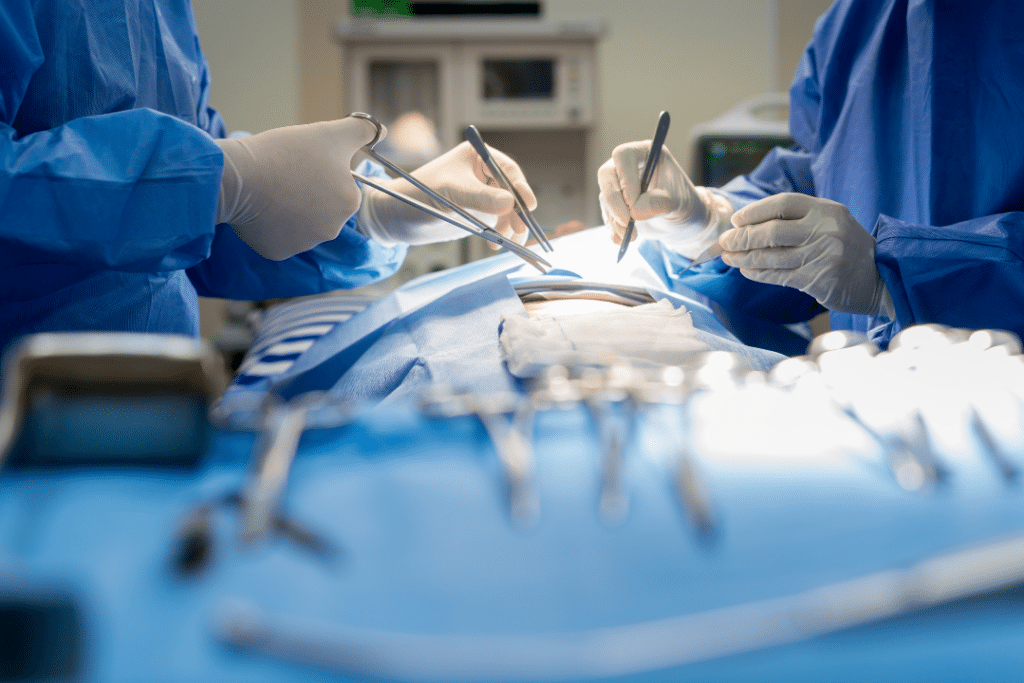|
Getting your Trinity Audio player ready...
|
Takeaways
- Cancer is a disease where body cells grow uncontrollably and spread. There are many types and can develop differently in men and women.
- Early detection of cancer increases your chances of survival. Awareness of early symptoms, such as chronic fatigue, unexplained weight change, and chronic coughing, can be lifesaving.
- Reducing your risk of developing cancer can be done by performing simple changes to your lifestyle.
What is Cancer?
When you hear the word “cancer,” what comes to your mind?
For most of us, it’s fear.
The fear of having to receive years of treatment. The fear of the cost of treatment. The fear of not knowing if the treatment will work.
Cancer is scary, but understanding cancer could help you control your fear. Understanding cancer could turn that fear into hope. In an important interview, one cancer expert, Michael Karlfeldt, ND, PhD, states, “You want to look at the basic foundation and then build up on there and then you can be successful in what you do.”
So, what exactly is cancer?
The National Cancer Institute defines cancer to be: “a disease in which some of the body’s cells grow uncontrollably and spread to other parts of the body.”
There are four main types of cancer cells:
- Carcinomas – cancer of the cell lining of your organs (the most common type of cancer)
- Sarcomas – cancer of the cells in your bones and soft tissues
- Leukemias – cancer of cells that form blood.
- Lymphomas – cancer that starts in your lymphatic system

These types of cancer cells can cause over 100 different types of cancers. The National Cancer Institute reports that in women, the most common cancers are:
- Breast
- Lung
- Colon or rectum
- Uterine
In men, the most common cancers are:
- Prostate
- Lung
- Colon or rectum
- Bladder
In 2023, the American Cancer Society expects 2 million diagnoses of cancer in the United States alone. Further, the American Cancer Society reports that 40.9% of people will develop any form of cancer in their lifetime.
Thankfully, the American Association for Cancer Research (AACR) reports that cancer survival rates are improving.
The most recent data available from the AACR states that the survival rate for all cancers have increased from 49% in the mid-1970s to almost 70% in 2017. That is an improvement of 21%.
The progress in understanding cancer symptoms, causes of cancer, prevention, and treatments is incredible. This blog will help you understand each of these so you can be armed with the knowledge you need.
Cancer Symptoms
What Causes Cancer?
Cells can have their DNA changed during cell growth and replication. This is called a “gene mutation.” Gene mutations are common, and your body often recognizes and repairs them.

If your body is not repairing these gene mutations, healthy cells can turn into cancer cells. When the cells divide uncontrollably, they are considered cancer.
According to the National Cancer Institute, cancerous gene mutations can cause:
- Changes in cell function
- Ability for cancer cells to hide from the immune system
- Cells to grow and divide uncontrollably
- Cells to begin invading other areas of the body
- Cancer cells to trick the body into helping them grow
All these changes are what make cancer so difficult to treat. The uncontrollable growth alone is challenging to deal with. But when the cancers trick your body into helping them grow, that is even more difficult to treat.
So, what causes these mutations?
Causes of Gene Mutations
There are many causes of the gene mutations that can lead to cancer. According to Stanford Medicine and the Center for Disease Control, these include:
- Smoking
- Excessive alcohol use
- Poor diet (high in processed, fatty foods and sugars)
- Exposure to toxic chemicals (pesticides, fertilizers, air pollution)
- Genetics disorders (inherited mutations or other disorders like Wiskott-Aldrich and Beckwith-Wiedemann syndromes)
- Exposure to viruses (Epstein-Barr virus and HIV for example)
- Excessive sunlight exposure
You can limit your risk of developing cancer by acting to limit the influence of as many of these causes as possible.
Being able to diagnose cancer early is essential. A 2015 literature review of over 175 studies found that diagnosing cancer earlier increases the chances of survival. Early diagnosis allows treatment to start earlier, and the treatment may last less time.
The Mayo Clinic states that the early signs of cancer are:
- Chronic Fatigue
- Irregular lumps or thickening under your skin
- Changes to moles or changes of skin color (yellowing, darkening irregularly, or redness)
- Irregular weight change
- Chronic coughing and/or trouble breathing
- Unexplained muscle or joint pain
- Unexplained bruises or bleeding
- Constant indigestion after eating
- Unexplained difficulty swallowing
Knowing the early symptoms of cancer could save your life. Be sure to consult your doctor if you are experiencing any of these symptoms.
Cancer Prevention
More important than anything is to get cancer screenings. Cancer screening is the best way to catch cancer early and improve your likelihood of survival.
In addition to cancer screenings, there are lifestyle changes you can make to reduce your cancer risk.
Quit Smoking or Avoid Smoking
Cigarette smoking is a key cause of lethal cancers. Approximately 80-90% of deaths due to lung cancer are caused by smoking or secondhand smoke. Cigarette smoking has also been linked to cancers of the mouth and throat, liver, stomach, and other areas of the body.
You can access the Mayo Clinic’s recommendations for how to quit smoking here.
Limit or Stop Consuming Alcohol
Alcohol use has been found to contribute to up to 3.7% of all cancer deaths in the United States. One key report found that greater use of alcohol was associated with a higher risk of developing cancer.
Avoiding alcohol or limiting alcohol intake will reduce your risk of developing cancer.

- Access the Cancer Breakthroughs Summit 2.0
Learn from top leaders in the field the skills you need today.
Eat a Healthy Diet
Harvard reports that a healthy diet can reduce the risk of cancer. One study reports that healthy eating habits reduces cancer risk by up to 20%.
Here are Harvard’s recommendations for a healthy diet:
- Limit “fast” food
- Limit red and processed meats
- Limit sugary foods and drinks
- Eat more whole grains, vegetables, fruits, and beans
Eating this type of diet can improve inflammation, microbiome health, and reduce the amount of stress on your body.
Exercise
Physical activity is known to reduce the risk of cancer. The National Cancer Institute reported that exercise can reduce the risk of many cancers including:
- Bladder Cancer
- Breast Cancer
- Colon Cancer
- Endometrial Cancer
- Esophageal Cancer
- Kidney Cancer
- Stomach Cancer
The recommended amount of physical activity includes
- Cardiovascular exercises (running, hiking, swimming, biking, etc.) for 150-300 minutes every week
- Strength training (weightlifting) at least 2 days per week
- Balance training (Pilates, yoga, calisthenics, etc.) to supplement both cardiovascular and strength training
These four lifestyle modifications can help you reduce your risk of developing cancer.
Cancer Treatments
If you have been diagnosed with cancer, it is important to know what treatment options are available to you. The most common forms of cancer treatment are:
- Surgery – doctors cut out the cancer
- Chemotherapy – medicines are given to shrink or kill cancers
- Radiation Therapy – radiation is used to kill the cancer

Depending on the type of cancer, you may have the option to undergo alternative therapies including:
- Hormone Therapy
- Hyperthermia
- Immunotherapy
- Photodynamic Therapy
- Stem Cell Transplants
- Other Targeted Therapies
Experts like Michael Karlfeldt, ND, PhD, states that it is important to trust the process and accept where you are. Because if you’re stressed, Dr. Karlfeldt states, “You get yourself in that survival mode, you know, fight or flight mode. And what you’re doing then is that you are producing more cortisol, you’re producing stress hormones which suppress the immune system which will trigger and triggers more inflammation and cancer is an inflammatory process… By being scared of facing death or trying to do everything you can to stop death from occurring, you put yourself at a place where you’re less likely to succeed.”
Summary
Cancer is a major health challenge. Alarmingly, nearly half of all people are at risk of developing cancer throughout life. But there’s hope. Survival rates have surged from 49% in the mid-1970s to nearly 70% in the mid-2010s. Prevention of cancer is extremely important. Know what you can do to embrace a healthy lifestyle. Finally, early detection is crucial and can increase your chances of survival. This paired with the variety of treatment options offer a brighter future for patients.
Cancer Videos from DrTalks
The Financial Burden of Cancer & Your Options
Overcoming Cancer Fear, Checkmate Diagnosis
Spirituality & Cancer Diagnosis
How to Starve Cancer; The Little Known Proven Principles
References
National Cancer Institute. (2021). What Is Cancer? National Cancer Institute; Cancer.gov. Read it here.
National Cancer Institute. (2018). Common Cancer Sites – Cancer Stat Facts. SEER. Read it here.
Siegel, R. L., Miller, K. D., Wagle, N. S., & Jemal, A. (2023). Cancer statistics, 2023. CA: a cancer journal for clinicians, 73(1), 17–48. Read it here.
American Cancer Society. (2023). Lifetime Probability of Developing and Dying from Cancer, 2017-2019 (Cancer Facts & Figures 2023 Supplemental Data). American Cancer Society; Cancer.org. Read it here.
CancerProgressReport.org. (2022). AACR Cancer Progress Report. Philadelphia: American Association for Cancer Research. Read it here.
Neal, R. D., Tharmanathan, P., France, B., Din, N. U., Cotton, S., Fallon-Ferguson, J., et al. (2015). Is increased time to diagnosis and treatment in symptomatic cancer associated with poorer outcomes? Systematic review. British journal of cancer, 112 Suppl 1(Suppl 1), S92–S107. Read it here.
Mayo Clinic Staff. (2018). Cancer – Symptoms and causes. Mayo Clinic. Read it here.
Stanford Health Care. (2014). What Causes Cancer? Stanford Health Care; stanfordhealthcare.org. Read it here.
Center for Disease Control and Prevention. (2019). Cancer. CDC; cdc.gov. Read it here.
Nelson, D. E., Jarman, D. W., Rehm, J., Greenfield, T. K., Rey, G., Kerr, W. C., Miller, P., Shield, K. D., Ye, Y., & Naimi, T. S. (2013). Alcohol-attributable cancer deaths and years of potential life lost in the United States. American journal of public health, 103(4), 641–648. Read it here.
IARC Working Group on the Evaluation of Carcinogenic Risks to Humans. (2010). Alcohol Consumption and Ethyl Carbamate. Lyon (FR): International Agency for Research on Cancer; (IARC Monographs on the Evaluation of Carcinogenic Risks to Humans, No. 96.) Read it here.
Harvard School of Public Health (2021). Preventing Cancer. Harvard T.H. Chan School of Public Health; The Nutrition Source. Read it here.
Grosso, G., Bella, F., Godos, J., Sciacca, S., Del Rio, D., Ray, S., Galvano, F., and Giovannuci E.L. (2017). Possible role of diet in cancer: systematic review and multiple meta-analyses of dietary patterns, lifestyle factors, and cancer risk. Nutrition Reviews, 75(6): 405-19. Read it here.
National Cancer Institute. (2020). Physical Activity and Cancer. National Cancer Institute; Cancer.gov. Read it here.



This topic is very important to me as I lost my 34 year old brother, Eric to Non-small Cell Carcinoma in 2006. So many of us have lost someone close or know someone who has lost a loved one to cancer. Eric was in the prime of his life having just received his PhD and ironically accepted a post doc fellowship at the Burnham Institute for Cancer Research – studying the very illness he succumbed to.
I’m so grateful to Drs. Eliaz and Karlfeldt for putting on the Cancer Breakthroughs Summit https://drtalks.com/cancer-breakthroughs-summit/ to get this critical new information out to those who need it most.
The summit had New breakthroughs in personalized precision medicine, the latest technologies in innovative cancer care, to fasting, food as medicine, the power of a healing community, and ancient modalities and healing techniques. I believe tens of thousands of people are better off now having watched and participated in this summit. THANK YOU Dr. Karlfeldt and Eliaz.
I am getting great benefit from the Cancer Summit and the Cancer Masterclass. I only wish I had the information sooner. I now have stage 4 non small cell adenocarcinoma. I was diagnosed stage 3 had 2/3 of R lung removed with pre surgical chemo and post surgical chemo and radiation. then Mets to glenoid process, had biopsy with cryosurgery, then Mets to lumbar spine which was successfully treated with radiation surgery. Then reoccurrence of shoulder Mets and retreated with radiation. My husband knew to put me on citracell immediately and I took resveratrol during chemo to prevent peripheral neuropathy. But there were MANY other things I could have been doing but didn’t know about. I’m very grateful to be learning. This is by far the most scientifically research based information I have yet to find and feel very blessed to have been fortunate enough to learn about the cancer summit and cancer Masterclass. I would highly recommend this to anyone and everyone. I have been involved in natural health and environmental medicine for almost 40 years and I recognize truth being told when I hear it. I am learning so much more with every hour I expose myself to this information. Thank you again.
Jo-ellen, thank you for sharing your story! I’m so glad the information has been beneficial for you. That’s why we do it!
We’d love to chat with you about your cancer and see how we could help! We offer a free cancer consultation to discuss possible options. If you’d like to reach out, you can set that up right here https://www.thekarlfeldtcenter.com/oncology/
I’m so glad you were able to join the Summit and Masterclass and learn more about integrative solutions for cancer. Thank you for joining us.
Just listened to Module 1 of Dr. Karlfeldt’s Cancer Resilient Body Master Class. Great information and very reassuring. I’m eager to dive into the Summit interviews. Thank you for all of your work, Bret!
Thank you Sam, we appreciate you. Please don’t keep Drtalks and Dr Karlfeldt a secret. Please share this post and summit with anyone you think can benefit from this great information. Let’s continue your healing journey together.
Thanks, Sam! We’re so glad you’re here, and as Bret said, please share so this info can reach as many people as possible!
I left an appointment with one of my four conventional medical oncologists. I told him during our meeting that “we can do better”. I had no idea that better existed but it bothered me that the recommended treatments all damaged and killed healthy cells and organs as collateral damage. Choosing the lesser of two evils is still choosing evil.
At a rest stop on my 4+ hour drive home, my girlfriend urged me to listen to a podcast and learn something rather than just music. I randomly browsed down and selected the most recent episode from “Integrative Cancer Solutions with Dr. Karlfeldt”.
It was the beginning of a change of life. December14, 2023 will be the one-year anniversary of that random podcast.
Dr. Michael Karlfeldt and Dr. Isaac Eliaz put together a tremendous resource in the Cancer Breakthroughs Summit. I rewatch parts of the programming on a daily basis. I am so happy that so many people wer able to watch and purchase the summit. There are advanced methods out there for healing that are detailed in the Summit interviews.
Peace, Love, and First, do no harm.
Wow Bill thank you for sharing with your comment. It really helps us help more people who are going through a similar healing journey. “We can do better” is a great mantra for all of us involved in helping people improve their health and wellbeing. We are so glad you followed Drs. Karlfeldt and Eliaz here to DrTalks. We hope you are well on your own healing journey and you keep getting better. Thank you!
Bill, that’s so amazing to hear! Thank you for sharing your story. It’s an honor to be part of your change of life. We can do better!
It was such a great time to chat with all of you during our module 1 session yesterday evening. I am excited for our get together next week to cover module 2.
Here are the protocols I suggested:
Eliminatory Pathways and Detoxification:
https://thekarlfeldtcenter.gethealthy.store/detoxification-bundle.html
Mitochondrial Activation:
https://thekarlfeldtcenter.gethealthy.store/ct-minerals-60-capsules.html
https://thekarlfeldtcenter.gethealthy.store/bc-atp-120-capsules.html
Endocrine Support:
https://thekarlfeldtcenter.gethealthy.store/s-tro-120-capsules.html
Thyroid Support:
https://thekarlfeldtcenter.gethealthy.store/metabolic-activator-2-fl-oz.html
Appreciate Dr Karlfedt commentary on educating and reassuring the reader with knowledge.
Thank you, Joe! I appreciate you joining us on this Webinar!
As a registered nurse, I can’t express enough gratitude for the doctors who tirelessly dedicate their time to educate patients and their loved ones about cancer and prevention. Thank you, Dr Michael and thank you DrTalks!
Thank you, Lesley! And thank you for your service as a registered nurse – it’s not an easy job and takes a lot of heart.
This enlightening blog profoundly impacts me, revealing the intricate battle against cancer. It’s a beacon of hope, guiding us through prevention, early detection, and treatment, profoundly influencing my understanding and approach to this life-altering challenge.
Thanks, Mila! So glad you’re here!
A powerful reminder of the dual challenge and progress in the fight against cancer.
Thanks for highlighting these crucial aspects!!
Thank you, Anita! And thank you for joining us! Please consider sharing so this info can reach as many people as possible!
The fear associated with the word “cancer” is something many of us can relate to, and this post does an excellent job of unraveling that fear by providing a clear understanding of the disease. Learning about the types, causes, and symptoms is not only informative but also empowering. It’s a wake-up call to the significance of early detection and the positive impact it can have on survival rates. The emphasis on lifestyle changes for cancer prevention feels personal, urging me to reflect on my habits such as adopting a healthier diet and regular exercise are not just general recommendations but resonate as actionable steps I can take to reduce my own risk.
Thanks, Pam! I’m so glad you are inspired to reflect on your habits and work on your health. Health is a life-long journey, not a short trip!
This blog really spoke to me about cancer, breaking down the fear and confusion. It highlighted the importance of catching it early and shared encouraging stats on survival rates. The tips on lifestyle changes felt relatable, making it clear how we can take charge. Overall, it’s a helpful guide, giving me a better understanding and a bit more hope when it comes to dealing with cancer.
Thank you, Raymond! I’m so glad you have found the webinar and blog so helpful and relatable. Please consider sharing so others can learn as well!
Thank you for this clear first master class – looking forward to the next ones! And I really enjoyed the Cancer Breakthrough Summit – very enlightening!
Being located in the Netherlands, I do have a question though: for me, the master classes take place in the middle of the night, so I won’t be able to attend to the live classes. Is there another way to ask questions?
Thanks, Jente! I’m so glad you’ve enjoyed it so far!
If you’d like, you can ask your questions here.
Thank you!
For now, I have the following questions for you:
Background: I was diagnosed with breast cancer in 2013, had the full works (mastectomy of my left breast, full lymph nodes removal of left axilla, chemotherapy, radiation, 5 years of tamoxifen). Unfortunately the cancer returned: in dec 2020 many metastases were discovered in my bones, mainly on my right side. One metastasis in my skull grew down into my brain, which made itself known through a seizure in April 2021. This was surgically removed, and I had stereotactic radiation afterwards. I used anti-seizure medication till October 2022, but unfortunately recently had a seizure again – according to the neurologist this time due to radiation necrosis.
Treatment so far: letrozol stopped working after almost 2 years, then over to Ibrance + Fulvestrant. I had 6 rounds of those, after which a PET/CT-scan showed only a little tumor activity in 1 thoracic vertebra. I’ve stopped regular treatments in June this year, and started two months of high dosage THC (mainly through suppositories, a bit orally as well). Besides, I’ve used COC repurposed drugs, many supplements, a change of regimen (using the mornings for meditation/qigong/taiji/other exercise), focusing on spiritual development. I’ll have another PET/CT-scan tomorrow, so very curious what news that will bring…
Thank you, Jente, for your questions! I appreciate you sharing your background and treatment so far as well.
We’d love to be able to talk with you more and see how we could help! We offer a free cancer consultation and I understand you’re located in the Netherlands so it can be done virtually. If you’d like to reach out, you can set that up here: https://www.thekarlfeldtcenter.com/oncology/.
Thanks again for joining us from the Netherlands!
In his presentation, dr Karlfeldt encourages us to read his book and says that we should have access to it. I’ve been looking but haven’t been able to find it. Does anyone know how/where to access the book?
Hello Jente, thank you for reaching out to us. We’ll send you an email to assist you with this. For reference, you may also email us at [email protected]
Thank you, Kimmy! I received your email, and found dr Karlfeldt’s book.